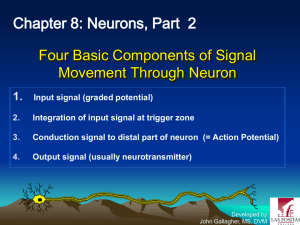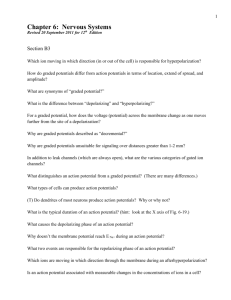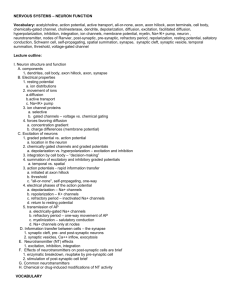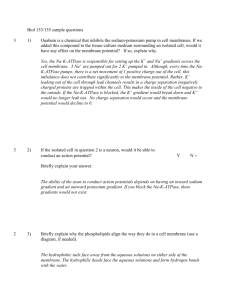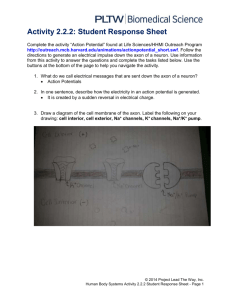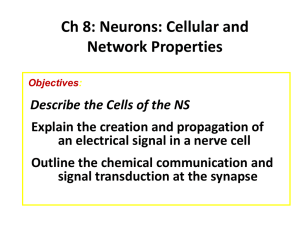Biology 251 Fall 2015 1 TOPIC 4: ACTION POTENTIALS AND
advertisement
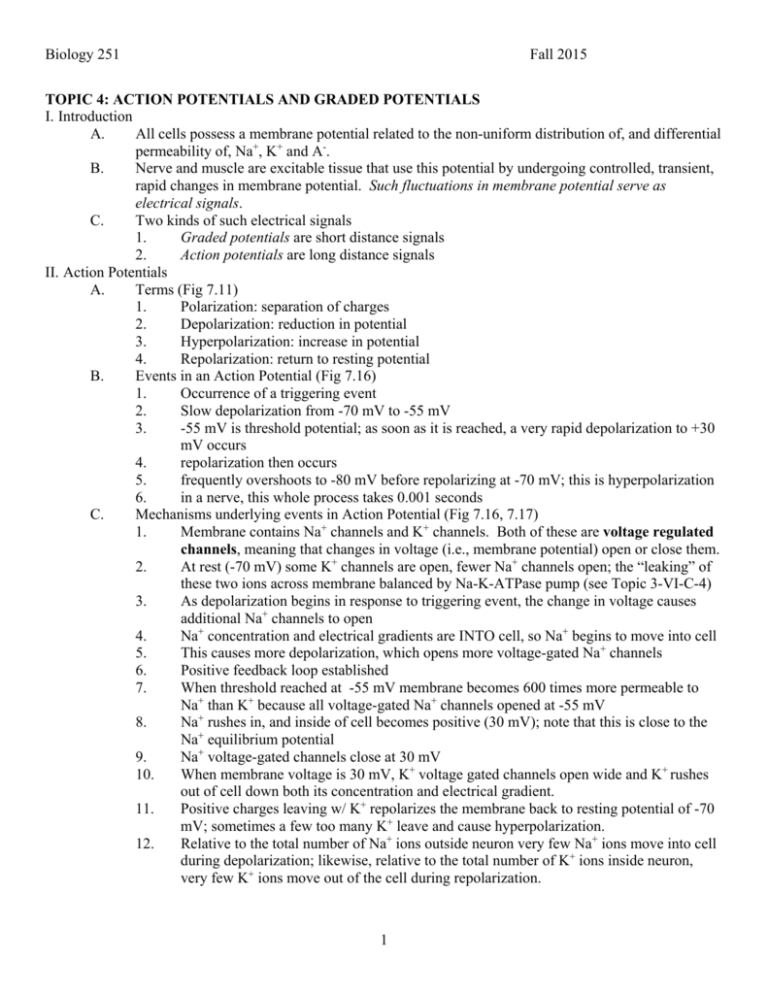
Biology 251 Fall 2015 TOPIC 4: ACTION POTENTIALS AND GRADED POTENTIALS I. Introduction A. All cells possess a membrane potential related to the non-uniform distribution of, and differential permeability of, Na+, K+ and A-. B. Nerve and muscle are excitable tissue that use this potential by undergoing controlled, transient, rapid changes in membrane potential. Such fluctuations in membrane potential serve as electrical signals. C. Two kinds of such electrical signals 1. Graded potentials are short distance signals 2. Action potentials are long distance signals II. Action Potentials A. Terms (Fig 7.11) 1. Polarization: separation of charges 2. Depolarization: reduction in potential 3. Hyperpolarization: increase in potential 4. Repolarization: return to resting potential B. Events in an Action Potential (Fig 7.16) 1. Occurrence of a triggering event 2. Slow depolarization from -70 mV to -55 mV 3. -55 mV is threshold potential; as soon as it is reached, a very rapid depolarization to +30 mV occurs 4. repolarization then occurs 5. frequently overshoots to -80 mV before repolarizing at -70 mV; this is hyperpolarization 6. in a nerve, this whole process takes 0.001 seconds C. Mechanisms underlying events in Action Potential (Fig 7.16, 7.17) 1. Membrane contains Na+ channels and K+ channels. Both of these are voltage regulated channels, meaning that changes in voltage (i.e., membrane potential) open or close them. 2. At rest (-70 mV) some K+ channels are open, fewer Na+ channels open; the “leaking” of these two ions across membrane balanced by Na-K-ATPase pump (see Topic 3-VI-C-4) 3. As depolarization begins in response to triggering event, the change in voltage causes additional Na+ channels to open 4. Na+ concentration and electrical gradients are INTO cell, so Na+ begins to move into cell 5. This causes more depolarization, which opens more voltage-gated Na+ channels 6. Positive feedback loop established 7. When threshold reached at -55 mV membrane becomes 600 times more permeable to Na+ than K+ because all voltage-gated Na+ channels opened at -55 mV 8. Na+ rushes in, and inside of cell becomes positive (30 mV); note that this is close to the Na+ equilibrium potential 9. Na+ voltage-gated channels close at 30 mV 10. When membrane voltage is 30 mV, K+ voltage gated channels open wide and K+ rushes out of cell down both its concentration and electrical gradient. 11. Positive charges leaving w/ K+ repolarizes the membrane back to resting potential of -70 mV; sometimes a few too many K+ leave and cause hyperpolarization. 12. Relative to the total number of Na+ ions outside neuron very few Na+ ions move into cell during depolarization; likewise, relative to the total number of K+ ions inside neuron, very few K+ ions move out of the cell during repolarization. 1 Biology 251 Fall 2015 D. Restoration of Ion Gradients 1. At completion, the resting membrane potential of -70 mV is restored, but concentrations of Na+ and K+ are not. 2. However, very few K+ and Na+ actually cross the membrane during an action potential compared to total amount of these ions available (only about 1 out of every 100,000 ions crosses the membrane) so their overall concentration is not changed much. 3. Eventually the original concentrations restored by Na+-K+ ATPase pump. Without this pump, repeated action potentials would eventually erode separation of Na+ and K+ III. The Neuron and Conduction of Action Potentials A. Neuron Structure (Fig 7.2) 1. Three parts a) cell body (1) nucleus and organelles b) dendrites (1) numerous extensions from cell body c) axon or nerve fiber (1) single elongated tubular extension (2) conducts action potentials away from cell body (3) may give off side branches or collaterals (4) has highly branched endings called axon terminals d) first portion of axon + region of cell body from which it leaves is called axon hillock 2. Can range in length from less 1 mm to over 1 meter (e.g., lower back to big toe) B. Conduction of Action Potential in a neuron (fig 7.22) 1. Initiated in axon hillock 2. Conduction of AP by local current flow down the axon 3. Resting potential in an adjacent inactive area is depolarized to threshold by local current flow in active area 4. First action potential triggers next one in adjacent area 5. This is a self perpetuating cycle down the neuron C. Mylenation (fig 7.7) 1. Myelin: fibers composed of lipids 2. Surrounds portion of axon, like rubber insulation 3. In CNS, myelin forming cells are called oligodendrocytes 4. In Peripheral NS, myelin formed by Schwann cells. 5. Gaps between myelin are called Nodes of Ranvier a) Impulse jumps from node to node; this is called saltatory conduction (fig 7.23) 6. Increases speed of the conduction of action potential 7. Multiple sclerosis is caused by autoimmune destruction of myelin D. Toilets and Guns: Special properties of action potentials 1. Refractory Period of action potentials (Fig 7.20) a) Don’t want action potential moving in both directions on axon, so a refractory period is required to keep APs from bouncing back and forth in a neuron. b) Absolute refractory period: Na+ gates are closed and inactivated; no action potential can occur c) Relative refractory period:action potential can occur, but stimulus must be much 2 Biology 251 Fall 2015 2. larger than normal to get one started. K+ gates are inactivated during this time. d) Refractory period similar to inability to flush a toilet twice in a row e) Ensures unidirectional movement of action potential, and sets an upper limit to the frequency of occurrence of action potentials All or None Law of action potentials a) Once an action potential starts, it WILL be conducted down the whole neuron. Similar to pulling a trigger on a gun IV. Graded Potentials A. A stimulus-caused local change in membrane potential that does not lead to an action potential 1. Most graded potentials occur in the cell body before the axon hillock. 2. Some graded potentials occur in cells that are not able to produce action potentials because they don’t have voltage gated ion channels that completely open and so they don’t have have a threshold potential. a) Most such graded potentials we will discuss are involved with the special senses (e.g., vision) B. The magnitude of change in potential proportional to magnitude of triggering event (Fig 7.12) 1. Triggering events a) stimulus (e.g., light stimulating special nerve cells in eye) b) interaction of chemical messenger with surface receptor on a nerve or muscle cell c) change in membrane potential caused by imbalanced leak-pump cycle C. Mechanism (Fig 7.13) 1. Triggering event changes potential of part of the membrane (e.g., from -70 mV to -60 mV) 2. A differential potential now exists in this area (active area) compared to rest of membrane (inactive area) 3. Because opposite charges attract, current (movement of charges) passively flows between the active area and adjacent inactive areas on both the inside and outside of the membrane. 4. Similar to the movement of current in electrical wires 5. The current flow quickly dissipates: they are short distance and short term changes 3
